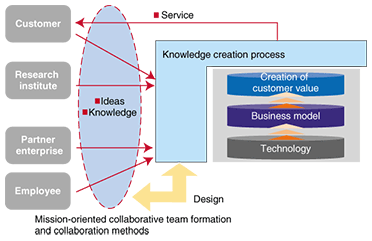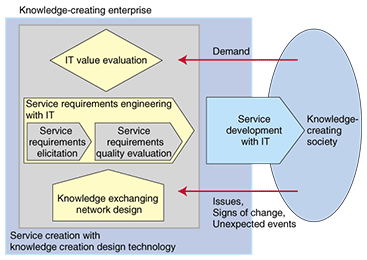 |
|||||||||||||||
|
|
|||||||||||||||
|
Special Feature: Knowledge Creation Design Methodology for Service Innovation Vol. 6, No. 7, pp. 5–9, July 2008. https://doi.org/10.53829/ntr200807sf1 Introduction to Development of Knowledge Creation Design TechnologyAbstractThis paper explains the nature of knowledge creation design technology and why it is needed now, in relation to our knowledge-creating society, which is expected to grow rapidly. It also outlines the main elements of the technology and talks about prospects for the future.
1. What is knowledge creation design technology?The 21st century is considered to be the era of the knowledge-creating society. The service industry makes up about 70% of all industry in Japan. Just looking at the manufacturing industry, services such as sales and logistics are part of the work performed. For example, if we consider an automobile as a typical product of the manufacturing industry, we see that it contains embedded software. A German automobile company claims that 90% of automobile innovation depends upon information technology (IT). In addition, Japan°«s information and communications technology industry makes up about 10% of the nation°«s entire industry. In other words, the central role of knowledge creation that makes society richer is the promotion of service innovation, and IT systems have a large role to play in achieving this. More and more, what an enterprise sells is not products but services [1]. Thus, the development of IT systems to support innovation is a knowledge-creating activity. Accordingly, it is important to have a framework in place to use IT systems to design knowledge creation processes that promote innovation. Although the word innovation is often understood in Japan in the narrow sense of only technical innovation, which is how it is defined in the Kojien dictionary, it actually refers to a much broader concept, the motivation for long-term economic changes, which include the innovation of manufacturing technologies, the introduction of new products, the development of new markets and resources, and the introduction of new management organizations. When we consider it in this broader sense, we can find examples of innovations made possible by IT systems, such as production technology innovations and new products (or services) resulting from IT systems, the development of new markets using IT systems, and the introduction of management organizations that take advantage of IT systems. What methods are there for designing the knowledge creation processes that are needed in a knowledge-creating society? In a knowledge-creating society, where knowledge has become a highly specialized form of activity, it is said that an organization is needed to create knowledge and that knowledge workers need to practice collaboration [1]. Moreover, in a knowledge-creating society, it is not possible for all knowledge to come from certain enterprises. Therefore, knowledge based innovation entails combining various types of information created by different organizations, and to succeed at this, there must be knowledge creation process management. Accordingly, one can understand that a knowledge creation design technology, such as that illustrated in Fig. 1, is necessary. In conclusion, there are two knowledge creation processes: a method that forms mission-oriented collaborative teams and a process that uses technologies such as IT systems to make specific business models that create customer value. For example, research has been conducted into a knowledge creation method in which, because IT systems are developed by project teams, the organization learns by performing postmortem analyses of past IT system developments and uses this to its advantage in subsequent IT system developments [2].
2. Knowledge that creates valueIn recent years, new information technology has come into wide use in all types of social settings, with the goal of greater communication and information exchange, particularly among enterprises and consumers. Typical examples are blogs and social networking services (SNSs). As the digitization of communication accelerates in society and business, the content of that communication is also becoming digital. This means that information that was once consumed on the spot and then gone is now digitized and stored on networks. In other words, the amount of digital information that is transmitted over a network and stored by it is growing exponentially. What is needed, therefore, is the development of new information technologies and methodologies to analyze and use this digital content. The Knowledge Sharing Network Research Group of the Japanese Society for Artificial Intelligence was formed in 2007 to answer questions such as what impact the digitization of knowledge communication would have on the distribution of knowledge and what initiatives would be necessary to further promote the distribution of knowledge [3]. The first research meeting included the presentation of a case study involving the use of an intra-enterprise SNS to encourage information sharing, a proposal for a social-model knowledge sharing model based on consumer generated media, a report on the effectiveness of a business intelligence service using knowledge management and Web 2.0, and another report on automatically generating a large search directory accommodating 1.2 million words, which is five times as many terms as in the sixth edition of the Kojien dictionary published by Iwanami Shoten (240,000 entries). Terms collected from the Internet, however, include many that are transient or of only special interest, and not all of them are necessarily useful for business purposes. Ultimately, value judgments by humans are important. An additional feature of the directory is that, by analyzing problematic expressions of particular terms in the context of usage scenarios, it can point out unexpected risks associated with those terms. For innovation, detecting such unexpected events is important. On the other hand, in the intra-enterprise SNS, when all employees participate, employees who have different senses of value can address one issue, cooperating in real time and exchanging knowledge from various points of view. These two methods are not in opposition to each other; rather, research should combine them in complementary ways. Besides technical initiatives, research into social aspects, such as the mutual trust that enables communities to form, is indispensable. 3. Intermediary knowledgeMuch of the knowledge that is distributed through an intra-enterprise SNS is fragmentary knowledge on the level of ideas and observations, which cannot be called explicit knowledge, so this type of knowledge is referred to as intermediary knowledge [4] and is distinguished from tacit knowledge and explicit knowledge (Table 1). Intermediary knowledge can be regarded as knowledge possessed by an intermediary who introduces the names of people who have the required knowledge. Tacit knowledge is subjective, individual knowledge. In contrast, explicit knowledge is objective, systematic knowledge. Intermediary knowledge is knowledge that is subjective but systematic. Furthermore, explicit knowledge is rational theoretical knowledge, whereas implicit knowledge and intermediary knowledge are experiential practical knowledge. Whereas tacit knowledge is analog knowledge, explicit knowledge and intermediary knowledge are digital knowledge. Thus, intermediary knowledge has aspects of both tacit and explicit knowledge.
I believe that by using intermediary knowledge, it may be possible to better explain the process of knowledge exchange on an intra-enterprise SNS. For example, up to now the only ways to distribute tacit knowledge have been to turn it into explicit knowledge or to gather members of the same team in the same place so they could work at the same time [5]. Looking at intermediary knowledge shared in an intra-enterprise SNS, employees exchange knowledge that is digitized yet fragmentary, while at the same time certain employees are working to create necessary knowledge on their own. The potential of Just In Time Knowledge Management (JIT-KM) using an intra-enterprise SNS is beginning to be recognized. The distribution of intermediary knowledge can also support organizational learning. For example, instead of turning an IT system°«s after-the-fact analysis results into explicit knowledge, it might be possible to distribute it as intermediary knowledge as needed. 4. Service requirements engineeringService innovation is classified in Table 2 according to who it is for, what is being created, and how it is being created. In current requirements engineering, existing customer requirements are extracted and IT systems developed accordingly, but in the future knowledge-creating society, it will be essential to know how to create unknown services for unknown customers. For example, in the suggestion type it will be necessary to propose unknown services to known customers. In the customer development type, new customers are brought in by reusing known services with unknown customers. In the customer-adaptive type, known means are reused and customized into new services for unknown customers. In the market creation type, unknown customers and unknown services are created. In order to create unknown customers and unknown services like this, it is essential to anticipate the potential of a wide variety of services and list the service requirements, without missing any. It is impossible, however, to develop all services, so some method is necessary for selecting services in consideration of importance and value. Research into new requirements engineering techniques for such innovations has much potential [6].
5. Knowledge creation design technology configuration exampleThe other articles in this Special Feature introduce an IT system value evaluation method, a goal-oriented requirements extraction method, a requirements quality evaluation method, and a knowledge sharing network design method. Combining these methods as in Fig. 2 has much potential for accelerating service innovation through the use of IT.
6. Future approachesKnowledge creation design technology is still new. It will continue to be evaluated and developed in the future. For example, intra-enterprise SNS and technical development community activities are currently being studied to develop knowledge creation design technology. References
|
|||||||||||||||












